Good afternoon, dear reader.
In the next article of the series "Pass the circuit with a half kick" we will talk about the competent execution of the exercise "Turns by 90 degrees".
Exercise "" refers to a group of new exercises that are used when passing exams at the traffic police starting from September 1, 2016.
Consider the scheme for performing this exercise.
Playground for exercise"90 Degree Turns" is shaped like a winding corridor:
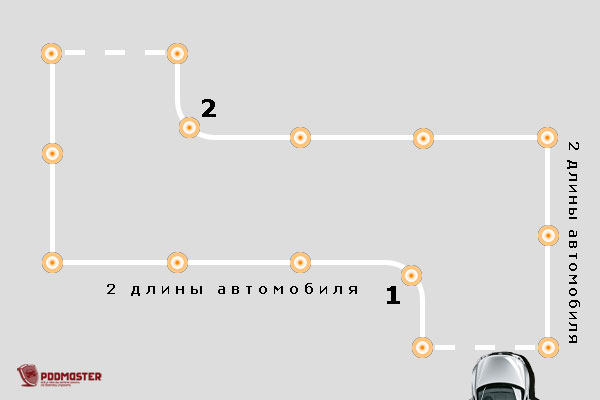
The width of the corridor is 3.9 meters. In practice, this means that the corridor is about 2 times wider than the training vehicle, i.e. enough room to maneuver.
The length of the sections of the corridor is equal to 2 lengths of the car body.
The corner radius is 1 meter.
When performing a turning exercise, the driver must do the following:
- Drive up to the start line of the exercise, stop.
- Enter the hallway and turn left 90 degrees.
- Make a 90 degree right turn.
- Drive up to the line of completion of the exercise, stop.
When performing this exercise, unlike the exercise, the car can only move forward, i.e. reverse gear is prohibited.
Table of errors for the exercise "Turns by 90 degrees"
The first column of the table contains descriptions of possible errors, and the second - the number of errors that can be made. 0 means that after the first mistake for the exam, the mark "NOT PASSED" is set.
| Error | Possible quantity |
| 113.1. Did not start the test exercise within 30 seconds after receiving the command (signal) to start its implementation. | 0 |
| 113.2. I drove my wheel onto the marking line marking the boundaries of the test exercise areas, or knocked down the marking equipment. | 2 |
| 113.3. Left (crossed with a wheel) beyond the boundaries of the test exercise areas, indicated by road marking lines 1.1 white or 1.41 yellow and marking cones (marking posts). | 0 |
| 113.7. Made the engine stop. | 2 |
| 113.9. Carried out the movement in reverse in the event that reverse movement is not provided for by the conditions for performing the test exercise. | 0 |
| 113.15. Left the exam (refused to perform the test exercise). | 0 |
How to make turns
Consider step by step instructions How to do the 90 degree turn exercise:
1. We drive up to the start line of the exercise and stop. At the same time, you need to drive up to the line in such a way that the car is as close as possible to the right edge of the corridor. This will make the exercise easier later on.
The closer you get to this side, the better. However, care must be taken not to catch the cones and cross the markings.
2. We move off and slowly move along the right side of the corridor parallel to it. You need to move until the left rear-view mirror is level with cone number 1.
The steering wheel of the car does not need to be turned at this stage. As soon as cone number 1 caught up with the rear-view mirror, we stop.
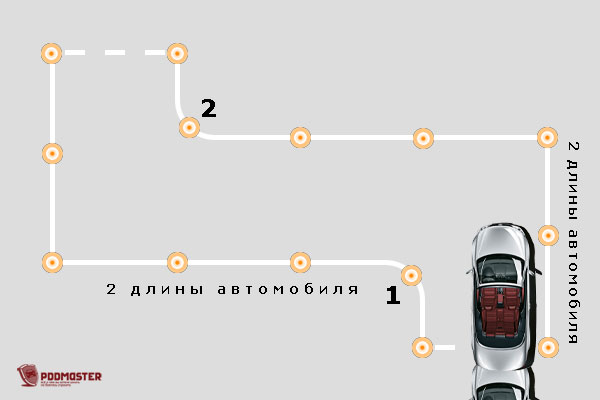
3. Standing still, turn the steering wheel of the car all the way to the left.
4. We start moving. The car then turns left. At this stage, you need to drive as close as possible to the left side of the corridor and stop parallel to it.
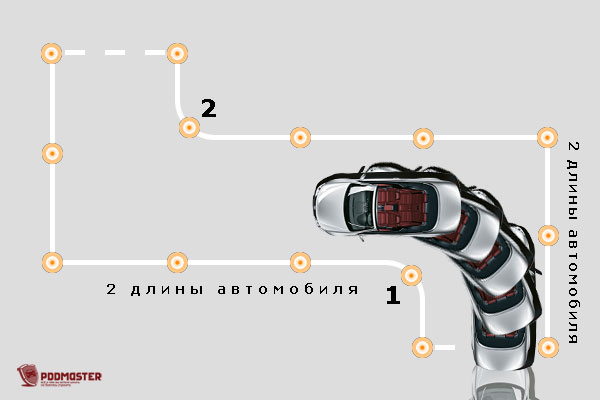
5. Set the steering wheel to a straight position and move parallel to the left wall of the corridor. At the same time, we follow cone number 2. As soon as this cone is at the level of the right mirror of the car, we stop.
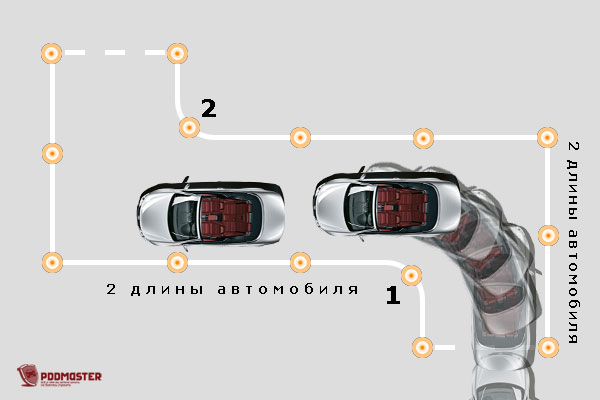
6. Standing still, turn the steering wheel of the car all the way to the right.
7. We start moving and perform the second right turn. We approach the line of completion of the exercise and stop. You can drive up to this line at any angle, it is not necessary to put the car perpendicular. This is not an error.
![]()
The exercise was successfully completed.
Instructions for performing the exercise turns
You can download the exercise manual in pdf format to use it directly on the circuit:
Possible errors and problems
Most problem areas when performing the exercise "Turns" - these are cones 1 and 2, which are inside the turn. If the driver candidate starts the turn ahead of time, then he can knock down these cones. However, if you strictly follow the above scheme, then you will not hook the cones.
Penalty points for 90 degree turns
Violations 113.2 (running into the line), 113.3 (crossing the line), 113.9 (turning on the reverse) the traffic police officer will notice exactly. Therefore, they should not be allowed.
As for violation 113.7 (engine stalled), it may not be noticed from afar. Therefore, if stalled, then just start the car and continue to do the exercise.
In general, the exercise "Turns 90 degrees" does not impose any supernatural requirements on drivers and is quite simple to complete.
Well, the next exercise on the circuit -.
Andrey-155
On account of the fact that if the engine stalls, from a distance it is almost not noticeable ...
How so if the traffic cop is sitting next to the student in the car?
Andrew, if he sits in the car, then of course he will notice.
In many examination divisions, the traffic police officer sits in another car and simultaneously watches several cars of the examiners. In this scenario, it is quite difficult to notice a stalled engine.
Good luck with exams!
Hello! We are forced to stop in front of the dotted lines at the beginning and end of each exercise, turning off the gear and raising the handbrake. At the same time, how critical will it be if the dotted line is slightly moved? To what point of violations does this error belong?
Maria, hello.
You need to stop only in those places where it is directly required. Before the start line of the exercise, it is not necessary to stop, driving without stopping should not be considered a mistake.
In this article, we will look at the procedure for performing the exercise “90 Turns”
90 degree turns
In this article, we will look at the procedure for performing the exercise “90 Turns”
The 90 turn exercise is one of the easiest exercises to do. To do it, you need to do a number of simple steps:
- we drive up to the beginning of the exercise, marking line 1.7, so that under the starboard side of the car and the solid marking line 1.1, a lateral interval of approximately 50 cm is subsequently formed, no more! (picture 1)
Then we start moving (Figure 2). Please note that the left mirror should be about half a meter from the next boundary of the exercise, marking line 1.1, which “rests” perpendicularly on the left side of our car. 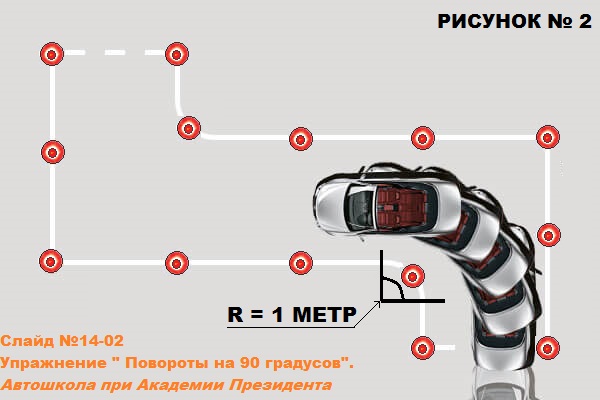
The ability of a candidate driver to demonstrate the rotation of the steering wheel while driving is welcome, but at the exam, as usual, there is excitement, uncertainty that you can cope with a new car, which you drive for the first time, but put doubts aside! The average training car has medium dimensions, and we will build on this. Being in position 1, either turn the steering wheel to the left with lightning speed, or stop the car and turn the steering wheel to the left. If you turned the steering wheel in place, i.e. stopping the car, in this case we resume the movement and let the car turn left.
-when turning left, carefully look in the left mirror, and wait for the car to take the position of the left side "stood" parallel to the border of the exercise. Align the wheels of the steering axle (Figure 3). 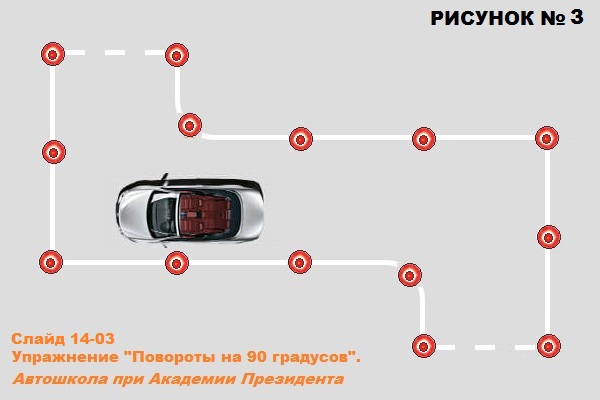
- then we “switch” our attention to the right mirror and drive the car a little forward, so that the right mirror is about half a meter from the border of the exercise, the solid marking line 1.1, which “looks” at our starboard side position 2 (Figure 3) and turn the steering wheel to the right. 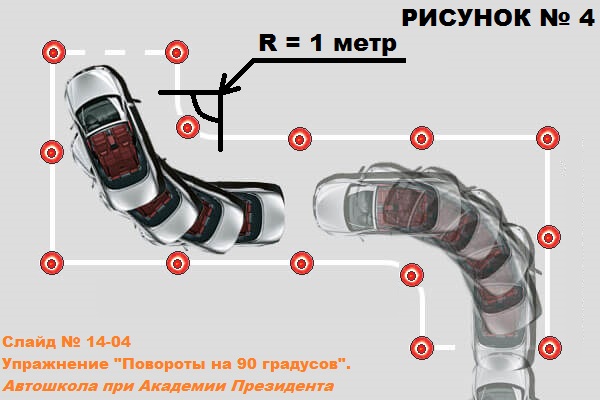
- after the car turned to the right, we align the wheels of the steering axle and leave the exercise (Figure 4).
Let me remind you that 2 minutes are given to complete the exercise. This time is more than enough. Take your time. No one forbids stopping the car during the exercise. Stopping, you get the opportunity to carefully look around and make a reasonable decision. And once again, if you can’t quickly turn the steering wheel on the go, stop and turn the steering wheel in place, but in this case, try not to keep the brake pressed so as not to create an unnecessary load on the steering mechanism.
Good luck!
Often they do not know how to avoid an accidental accident if there is a sharp turn ahead of them. As a result, an accident occurs and, as a result, not consoling consequences. This article contains all the necessary information on how to avoid getting into traffic accidents that are not related to. And the original crown of the article will be the brilliant saying of professional car instructors: learning to drive is learning the rules, and the path to mastery is learning the exceptions.
To avoid if there is a sharp turn ahead, you need to choose the right speed, take a larger radius and be prepared for the appearance of an obstacle from the so-called dead zone.
Sooner or later, a novice driver will have to learn how to quickly pass a sharp turn. The fact that such a skill is necessary for absolutely all motorists is not a secret. Both a policeman, during a chase, and an ordinary driver, following in a certain direction, must learn how to turn correctly. There are many techniques and ways to pass such a turn.
Method 1, or Turn 90 degrees
Let's start with the first method, which implies the maximum approach to the right side of the road if a sharp turn goes to the left. Thus, it is possible to significantly reduce the curvature of the trajectory and increase the reliability of the maneuver. Needless to say, if you need to turn right, you should get as close as possible to the left side of the road.
This method of passing a sharp turn also implies knowledge of such a term as apex. What is an apex? This is the point on the trajectory that is closest to the inside of the turn. And when passing a sharp turn, you should turn as close to the apex as possible, but so as not to catch the curb. The apex method is recommended only on a one-way road.
Passing a sharp turn, you need to brake as late as possible. When turning, you need to slightly, to thereby prevent. And you should slow down until the car slows down to a speed that is safe for cornering. The driver must feel this speed. But you can’t slow down much, as the car may deviate from a safe trajectory.
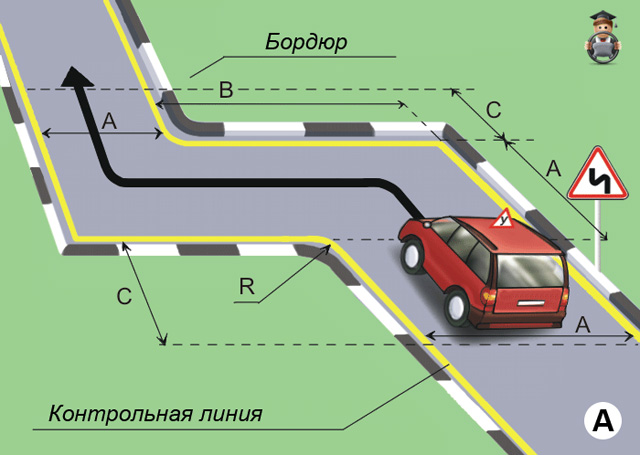
If you are going through a tight corner at the apex, you also need to apply the brake lightly, as this will slow down the movement of the front drive wheels, greatly improving their grip on the road. The gas pedal should be pressed until the car goes straight. After passing the apex, you will need to add gas to level the car.
Now about that, after passing a sharp turn. Here it is important to get out of the turn again as close to the right edge of the road as possible. This will increase the radius and flatten the path as much as possible. In addition, this will allow you to move with . The driver in this case achieves maximum traction and does not interfere with the traffic behind.
Method 2, or 180° turn (police drive)
In this case, you must definitely move at a speed of 55–60 km / h - no more. Only this speed can be considered safe when passing a sharp turn of 180 degrees. This type of turn is also called a handbrake drive, as it involves connecting the parking brake. It is clear that this reversal technique is not easy and is not intended for beginners.
Before making a police U-turn, you should correctly place your hands on. They should be placed in such a way that it is easy to scroll the steering wheel by making a full turn.
The video shows how a "police turn" is performed:
So, if you are going to turn to the right, the hand needs to be moved to the left (right). This makes it possible to turn the steering wheel much faster.
You need to start the turn by releasing the gas pedal. On you need to turn on the neutral position, on the manual transmission - squeeze the clutch all the way. And immediately turn the steering wheel in the direction of the turn until the wheels are blocked. Immediately after this, you must apply the parking brake. So get blocked rear wheels and this will eliminate the possibility of uncontrolled skidding.
It is important at such a moment when the car is moving in the opposite direction, not to get confused. Straighten the vehicle and release the parking brake.
A sharp turn is passed and if you need to get into the right lane, you need to slow down a bit. Press the brake pedal lightly to prevent skidding.
Method 3, or How to pass a gentle quick bend
In this case, it is necessary to hold the steering wheel with both hands. We start the car into a bend gently, acting carefully with the steering wheel and lightly pressing the gas pedal.
It must be remembered that at such a moment, the more we press the gas pedal, the wider the trajectory will be, and the less gas there is, the steeper it will become. Therefore, in this case, control the turning radius. For example, if the car tends to turn too much, then a skid occurs. rear axle. At this point, you need to fully release the gas pedal, and let the steering wheel slide a little in your hands. When the car starts to level off, gas can be added.
The video shows how to pass a sharp turn:
At the moment of completion of the maneuver, you need to add gas again, since maneuvering the steering wheel at this moment is dangerous.
sharp turn road sign
You can find out that there is a sharp turn ahead by. Therefore, you should always be attentive and focused behind the wheel. At such moments, limited visibility can play a cruel joke.
In general, it is a very important section of the road for the driver, and especially in winter. As you know, at such a moment, a centrifugal force acts on the car, tending to throw the car off the road. At the same time, speed becomes the most faithful ally of centrifugal force. If the speed is doubled, then the centrifugal force is four.
The sharp turn of the road sign is always installed on the roads, but you still need to be careful. the sign "Dangerous turn" refers to the warning. It is usually installed 100-300 meters before the turn so that the driver has time to prepare for it. It is important to know that overtaking when making a sharp turn is prohibited, but overtaking is allowed on the road from the sign to the start of the turn.
And in conclusion, I would like to wish all drivers good luck on the roads and constant concentration. Driving a car is first of all a great responsibility, and only then a pleasure - remember this!
13 things to remember when life hits you in the head 1. What is, is. The famous saying of the Buddha says: "Your suffering is caused by your resistance to what is." Think about it for a minute. This means that suffering is possible only when we refuse to accept what is happening. If you can change something, take action. But if change is not possible, then you have two options: accept the situation and let go of the negative, or long, passionately and passionately suffer. 2. A problem only becomes a problem when you call it that. We often become our own worst enemies. Happiness really depends on the point of view. If you consider something a problem, then your emotions and thoughts will be filled with negativity. Think about what lessons you can learn from the situation and it will suddenly stop being a problem. 3. If you want to change things, start by changing yourself. Your outer world is a reflection of your inner world. You probably know people whose lives are full of chaos and stress. And isn't this because they themselves are in a completely random order? We like to think that changing circumstances change us. In fact, it works in the opposite direction: we must change ourselves in order to change circumstances. 4. There is no concept of "failure" - only the opportunity to learn something. You should simply eliminate the word "failure" from your vocabulary. All great people have failed over and over again before they succeed. It seems that Thomas Edison said this: “I did not fail in inventing the light bulb. I just found 99 ways it doesn't work." Learn something from your so-called failures. Learn how to do it better next time. 5. If you're not getting what you want, something better is on the way. I know it's hard to believe sometimes. But it's true. Usually, when you look back at your life, you realize that good things happened after things didn't work out. Perhaps the job you weren't hired for would have alienated you from your family, unlike the one you ended up with. Just trust that everything is happening exactly as it should be. 6. Appreciate the present moment. It will never come again. There is something precious in every moment of life, don't let it pass you by. Soon everything will become a memory. Perhaps one day you will miss even those moments that now do not seem happy. 7. Let go of desires. Most people live with a "connected mind". This means that they attach great importance to their desires, and if they do not get what they want, then their emotions fall into negativity. Instead, try practicing "separate mind": if you want something, you will still be happy whether you get what you want or not. Your emotions in this state remain neutral or positive. 8. Understand your fears and be grateful for them. Fear can be a great teacher. And overcoming fear often gets you closer to victory. For example, when I was in college, I was afraid of public speaking. So now I find it funny that I not only speak to a group of people every day as a teacher, but also teach the art of public speaking. It takes practice to overcome fear. Fear is just an illusion. 9. Allow yourself to experience joy. Believe it or not, I know way too many people who don't allow themselves to have fun. They don't even know how to be happy. Some are so addicted to their problems and internal chaos that they have no idea who they are without all this. So try to allow yourself to be happy. It may be a small moment, but it is important to focus on the joys and not on the difficulties. 10. Don't compare yourself to others. But if you compare, then only with those who are worse than you. Unemployed? Be grateful at least for the fact that you receive unemployment benefits. Most people in the world live in extreme poverty. Doesn't look like Angelina Jolie? I don't think there are very many people like her. And you are probably much more attractive than most. Focus on it. 11. You are not a victim. You are only a victim of your own thoughts, words and actions. No one is doing anything especially for you or against you. You create your own experience. Take personal responsibility and realize that you can survive the hardships. You just need to start by changing your thoughts and actions. Let go of the victim mentality and become a winner. 12. Everything can and will change. “This too shall pass” is one of my favorite sayings. When we are stuck in a bad situation, it seems to us that there is no way out. It seems that nothing will change. But you know what? There will be changes! Nothing lasts forever except death. So give up the habit of thinking that everything will remain so forever. Will not remain. But you will have to take some action to change the situation. She can't magically change herself. 13. Everything is possible. Miracles happen daily. This is true. It is a pity that it is impossible to describe in one article all the amazing things that happened to my friends, from the healing of the fourth stage of cancer to a sudden meeting with my soulmate. This happens all the time. You just have to believe that it happens. Once you believe, you can already win the battle.
This exam exercise is considered not difficult. The exercise "Turns by 90 degrees" refers to a group of new exercises that are used when passing exams at the traffic police starting from September 1, 2016.
90 degree turn exercise area
The site has the shape of a winding corridor with rectangular turns. The width of this corridor is 3.9 meters (about 2 times wider than the training vehicle, there is enough space for maneuvers.
The length of the sections of the corridor is equal to two lengths of the car body. The radius of curvature on corners is 1 meter.
Algorithm for performing the exercise "Turns by 90 degrees"
- We drive up to the line of the beginning of the exercise (as close as possible to the right edge of the corridor), we stop. It is important not to hook the cones and not cross the markings.
- We move from a place and move in parallel right side, until the left rear-view mirror is level with cone No. 1, we stop.
- Turn the steering wheel all the way to the left. We start moving by turning left. You need to drive as close as possible to the left side of the corridor and stop parallel to it.
- When the car is parallel, we put the steering wheel straight and drive further straight along the corridor. As soon as cone No. 2 is at the level of the right mirror of the car, we stop.
- Turn the steering wheel all the way to the right. We start moving by turning right. We approach the line of completion of the exercise and stop. This line can be approached from any angle.
Exercise done!
Mistakes when performing the exercise "Turns 90 degrees"
| Error | Permissible Quantity |
|---|---|
| 113.1. Did not start the test exercise within 30 seconds after receiving the command (signal) to start its implementation. | 0 |
| 113.2. I drove my wheel onto the marking line marking the boundaries of the test exercise areas, or knocked down the marking equipment. | 2 |
| 113.3. Left (crossed with a wheel) beyond the boundaries of the test exercise areas, indicated by road marking lines 1.1 white or 1.41 yellow and marking cones (marking posts). | 0 |
| 113.7. Made the engine stop. | 2 |
| 113.9. Carried out movement in reverse if the movement in reverse is not provided for by the conditions of the test exercise. | 0 |
| 113.15. Left the exam (refused to perform the test exercise). | 0 |
Zero in the column "Permissible quantity" means that such an error immediately leads to setting the mark "NOT PASSED"!!!
Good luck on your exam!
